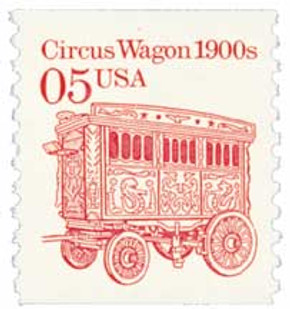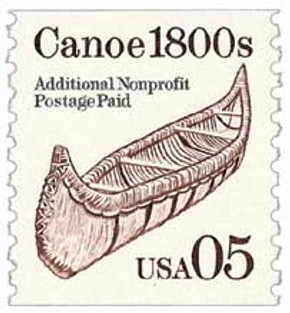
US #2451
1991 Steam Carriage
- First Transportation Series coil stamp
- 48th face-different stamp in the series
- Used as make-up rate stamp
Category of Stamp: Definitive
Set: Transportation Series
Value: 4¢
First Day of Issue: January 25, 1991
First Day City: Tucson, Arizona
Quantity Issued: 508,000,000
Printed by: Bureau of Engraving and Printing
Printing Method: Engraved
Format: Coils of 500 and 3,000, from sleeve of 936 subjects (18 across, 52 down)
Perforations: 9.8
Reason the stamp was issued: The 4¢ stamp was issued in response to an increase in the rate of First-class mail from 25¢ to 29¢.
About the stamp design: The stamp pictures the Dudgeon steam carriage. Richard Schlecht designed the stamp based on a photo of the original carriage that is housed in the Smithsonian Institution.
First Day City: The stamp was issued at Aripex, a stamp show sponsored by the Arizona Federation of Stamp Clubs.
Unusual thing about this stamp: This stamp was issued both with and without phosphorescent tagging. The USPS changed its policy concerning low-value stamps while this stamp was in production. As of January 1,1991, all stamps with values less than 8¢ were no longer given tagging. This was because they found many examples where an envelope with only a low-value stamp made it through the automatic stamp cancelling machines as if First-Class postage had been paid. Without the tagging, the newer stamps would be rejected by the cancelling machine.
About the Transportation Series: On May 18, 1981, the USPS issued the first stamp in the Transportation Series, US #1907, picturing the Surrey, a doorless four-wheeled carriage. For the first time in US history, a coil stamp featured its own unique design rather than simply copying that of the current definitive stamp. Over 50 more coil stamps would be issued over the course of the next 15 years, each picturing a different mode of transportation. All of these types of transportation were used since American independence.
The various denominations provided face values to exactly match the rates for several categories of Third-Class mail (bulk rate and quantity-discounted mail). As the rates changed, new stamps with new values were added. Never before had a stamp series included so many fractional cent values.
The Bureau of Engraving and Printing printed most of the stamps in the Transportation Series, although private contractors printed a few. All but a few of the later stamps were produced by engraved intaglio. Differences in precancels, tagging, paper and gum provide a large number of varieties.
Scott Catalog separates the Transportation stamps into four groups. The stamps in the first group (#1897-1908) generally have the denomination in small type with a “c” next to it. These stamps were printed on the Cottrell rotary press, which joined together two plates to make a sleeve. The gaps between these plates created depressions where ink would collect and create joint lines on the stamps. Later issues were printed on a different press and didn’t have these joint lines.
The second group (#2123-36) had larger numbers with no “c.” The third group (#2252-66) was similar in appearance to the second group, but service inscriptions were added to the designs. These stamps also used a variety of paper and gum as well as different types of tagging. The fourth group (#2451-68) marked the end of fractional values. Now bulk mailers would use either the 5¢ or 10¢ stamp and then pay the difference from the actual postage rate.
The last stamp in the Transportation Series, the 20¢ Cog Railway, was issued on June 9, 1995, at the TEXPEX ’95 stamp show in Dallas, Texas. This marked the end of the largest US definitive series up to that time and the largest US coil stamp series in history. Three new series would eventually replace it – American Transportation, American Culture, and American Scenes. Additionally, the Great Americans would go on to become the largest American definitive series.
History the stamp represents: The 1886 Steam Carriage was one of the earliest self-propelled vehicles. It was invented by Richard Dudgeon, a New Yorker who owned a machine works. He finished his first steam-powered carriage in 1857. When it was destroyed in a fire, Dudgeon built another model.
The body of the steam carriage consisted of a wide wooden framework mounted on top of a horizontal boiler barrel. Shallow water tanks were placed on either side, forming bench seats that provided enough room for 10 passengers. This novelty never gained popularity, because its iron wheels were noisy on New York’s cobblestone streets, the wooden benches were uncomfortable, and the smokestack sent smoke and cinders into passenger’s eyes.















